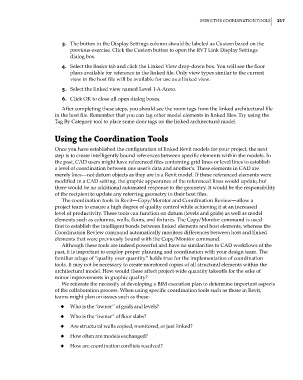Page 251 - Divyank Tyagi
P. 251
|
using the Coordination tools 217
3. The button in the Display Settings column should be labeled as Custom based on the
previous exercise. Click the Custom button to open the RVT Link Display Settings
dialog box.
4. Select the Basics tab and click the Linked View drop-down box. You will see the floor
plans available for reference in the linked file. Only view types similar to the current
view in the host file will be available for use as a linked view.
5. Select the linked view named Level 1-A-Anno.
6. Click OK to close all open dialog boxes.
After completing these steps, you should see the room tags from the linked architectural file
in the host file. Remember that you can tag other model elements in linked files. Try using the
Tag By Category tool to place some door tags on the linked architectural model.
Using the Coordination tools
Once you have established the configuration of linked Revit models for your project, the next
step is to create intelligently bound references between specific elements within the models. In
the past, CAD users might have referenced files containing grid lines or level lines to establish
a level of coordination between one user’s data and another’s. These elements in CAD are
merely lines—not datum objects as they are in a Revit model. If these referenced elements were
modified in a CAD setting, the graphic appearance of the referenced lines would update, but
there would be no additional automated response to the geometry. It would be the responsibility
of the recipient to update any referring geometry in their host files.
The coordination tools in Revit—Copy/Monitor and Coordination Review—allow a
project team to ensure a high degree of quality control while achieving it at an increased
level of productivity. These tools can function on datum (levels and grids) as well as model
elements such as columns, walls, floors, and fixtures. The Copy/Monitor command is used
first to establish the intelligent bonds between linked elements and host elements, whereas the
Coordination Review command automatically monitors differences between host and linked
elements that were previously bound with the Copy/Monitor command.
Although these tools are indeed powerful and have no similarities to CAD workflows of the
past, it is important to employ proper planning and coordination with your design team. The
familiar adage of “quality over quantity” holds true for the implementation of coordination
tools. It may not be necessary to create monitored copies of all structural elements within the
architectural model. How would these affect project-wide quantity takeoffs for the sake of
minor improvements in graphic quality?
We reiterate the necessity of developing a BIM execution plan to determine important aspects
of the collaboration process. When using specific coordination tools such as those in Revit,
teams might plan on issues such as these:
◆ ◆ Who is the “owner” of grids and levels?
◆ ◆ Who is the “owner” of floor slabs?
◆ ◆ Are structural walls copied, monitored, or just linked?
◆ ◆ How often are models exchanged?
◆ ◆ How are coordination conflicts resolved?
c06.indd 217 5/3/2014 12:48:06 PM

